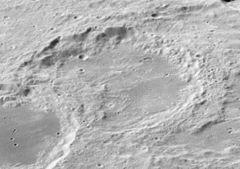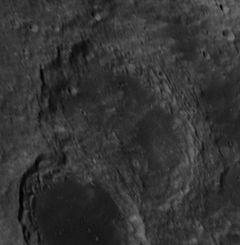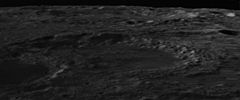 Oblique Apollo 16 mapping camera image | |
| Coordinates | 30°12′N 98°54′E / 30.2°N 98.9°E |
|---|---|
| Diameter | 107 km |
| Depth | Unknown |
| Colongitude | 263° at sunrise |
| Eponym | James C. Maxwell |

Maxwell is a crater on the far side of the Moon named after the physicist James C. Maxwell. It lies in the southwestern part of the larger crater Richardson. The southern part of Maxwell is overlain in turn by the partly flooded Lomonosov. Less than one crater diameter to the southwest is the larger Joliot.
The surviving outer rim of Maxwell is generally uneven and ill-defined where it overlies Richardson. Only along the western edge is it fairly well organized, but even there it is worn and eroded. The interior floor is relatively level and displays patches of low-albedo material, usually an indication of basaltic lava, possibly from impact melt. However the floor is dusted with material from the ray system of Giordano Bruno, located to the north-northeast, which has lightened the surface. The southern part of the interior floor is overlain by the outer rampart of Lomonosov.
Prior to formal naming in 1961 by the IAU,[1] this crater was known as Crater 112.[2]
References
- ^ Maxwell, Gazetteer of Planetary Nomenclature, International Astronomical Union (IAU) Working Group for Planetary System Nomenclature (WGPSN)
- ^ Lunar Farside Chart (LFC-1A)
- Andersson, L. E.; Whitaker, E. A. (1982). NASA Catalogue of Lunar Nomenclature. NASA RP-1097.
- Blue, Jennifer (July 25, 2007). "Gazetteer of Planetary Nomenclature". USGS. Retrieved 2007-08-05.
- Bussey, B.; Spudis, P. (2004). The Clementine Atlas of the Moon. New York: Cambridge University Press. ISBN 978-0-521-81528-4.
- Cocks, Elijah E.; Cocks, Josiah C. (1995). Who's Who on the Moon: A Biographical Dictionary of Lunar Nomenclature. Tudor Publishers. ISBN 978-0-936389-27-1.
- McDowell, Jonathan (July 15, 2007). "Lunar Nomenclature". Jonathan's Space Report. Retrieved 2007-10-24.
- Menzel, D. H.; Minnaert, M.; Levin, B.; Dollfus, A.; Bell, B. (1971). "Report on Lunar Nomenclature by the Working Group of Commission 17 of the IAU". Space Science Reviews. 12 (2): 136–186. Bibcode:1971SSRv...12..136M. doi:10.1007/BF00171763.
- Moore, Patrick (2001). On the Moon. Sterling Publishing Co. ISBN 978-0-304-35469-6.
- Price, Fred W. (1988). The Moon Observer's Handbook. Cambridge University Press. ISBN 978-0-521-33500-3.
- Rükl, Antonín (1990). Atlas of the Moon. Kalmbach Books. ISBN 978-0-913135-17-4.
- Webb, Rev. T. W. (1962). Celestial Objects for Common Telescopes (6th revised ed.). Dover. ISBN 978-0-486-20917-3.
- Whitaker, Ewen A. (1999). Mapping and Naming the Moon. Cambridge University Press. ISBN 978-0-521-62248-6.
- Wlasuk, Peter T. (2000). Observing the Moon. Springer. ISBN 978-1-85233-193-1.
